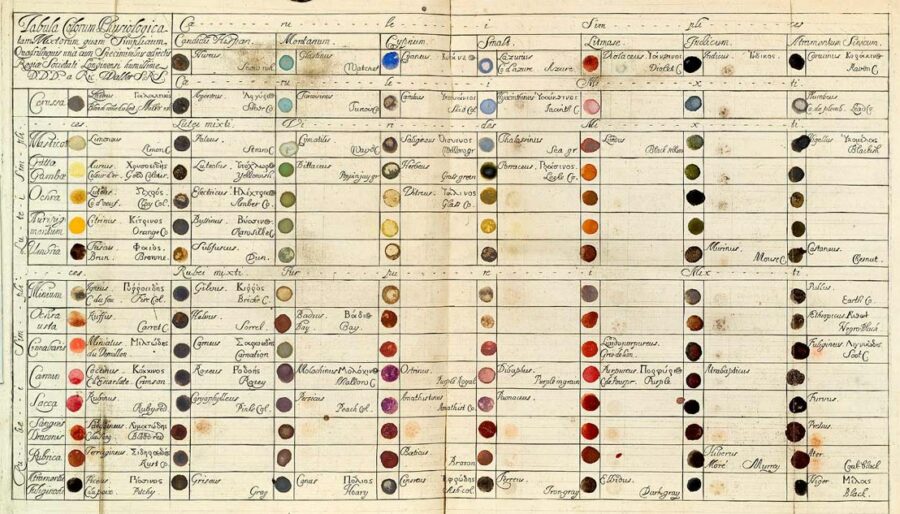
The period called the Enlightenment produced a revolution in which one sense, vision, became privileged above all others. As a result, Sachiko Kusukawa writes at The Royal Society Journal of the History of Science, “science is supremely visual. Indeed, one might say, excessively so.” Kusukawa situates English naturalist and illustrator Richard Waller at the beginning of her history about how sight came to dominate, and Sarah Lowengard places Waller’s color chart, presented at the Royal Society in 1686, at a formative moment in “the creation of color in Eighteenth-Century Europe.”
That’s not to say, of course, that color didn’t exist before charts like Waller’s, but it didn’t exist in neat taxonomies that divided color discretely, named and categorized it, and mapped the natural world by means of color theory. Waller’s “‘Table of Physiological Colors Both Mixt and Simple’ would permit unambiguous descriptions of the colors of natural bodies. To describe a plant, for example, one could compare it to the chart and use the names found there to identify the colors of the bark, wood, leaves, etc. Similar applications of the information collected in the chart might also extend to the arts and trades, he suggested.”
The naturalist approach to color would inform the artificial creation of color, helping “manufacturers to produce consistent dyes and paints,” notes the Smithsonian Libraries. Waller’s system was not precise enough for the task, but many others, including board game pioneer Milton Bradley, picked up his work and refined it, producing not only scientific and industrial color guides, but also pedagogies like Bradley’s Elementary Color textbook for children. Keith Moore, Head of Library & Information Services at the Royal Society, traces Waller’s color dots through the arts, “from the low art Ben-Day dots in the vintage comic books I used to read as a child to the high art pointillism and divisionism pioneered by Georges Seurat.”
Dozens of color systems, wheels, charts, and tables appeared over the next few hundred years, from the elaborate to the very simple. All of them have encountered the same basic issue, namely the subjectivity of visual perception. “Waller’s visual system exhibits the same conceptual problem… that plagued nearly all eighteenth-century classification systems. Which colors can be included and what is their ‘correct’ order? The answer was always tempered by available coloring materials and choice of media.” As more pigments became available, so too did more colors in the color charts.
Is the making of color classification systems more of a science or an art? It depends, perhaps, on what they’re used for, but “color remains elusive to scientists and color experts,” the Smithsonian points out, over 400 years after Waller’s chart. Since then, however, the language of color has evolved, as he envisioned, into a practical and poetic syntax and vocabulary.
See a larger version of the chart here and read about it in detail in Lowengard’s excellent article.
Related Content:
Werner’s Nomenclature of Colour, the 19th-Century “Color Dictionary” Used by Charles Darwin (1814)
A Pre-Pantone Guide to Colors: Dutch Book From 1692 Documents Every Color Under the Sun
The Vibrant Color Wheels Designed by Goethe, Newton & Other Theorists of Color (1665-1810)
Josh Jones is a writer and musician based in Durham, NC. Follow him at @jdmagness
Behold One of the Earliest Known Color Charts: The Table of Physiological Colors (1686) is a post from: Open Culture. Follow us on Facebook, Twitter, and Google Plus, or get our Daily Email. And don't miss our big collections of Free Online Courses, Free Online Movies, Free eBooks, Free Audio Books, Free Foreign Language Lessons, and MOOCs.
from Open Culture https://ift.tt/36VMtlo
via Ilumina
Comments
Post a Comment